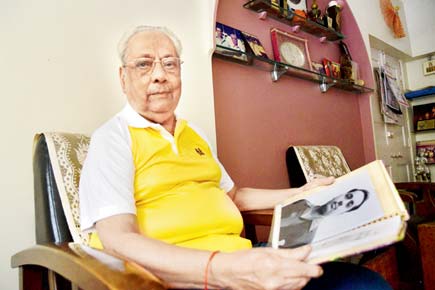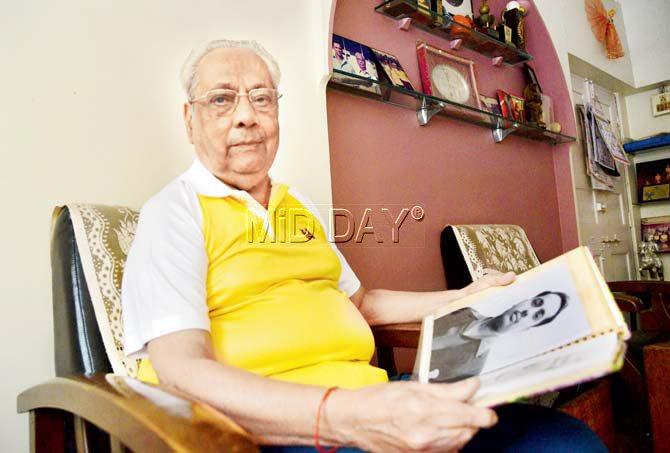Mumbai’s oldest surviving Test cricketer Dr Chandrakant Patankar is 86 today. His life story is as fascinating as his 18-year cricketing career


Chandrakant Patankar at his residence in Mumbai yesterday. Pic/Suresh Karkera
ADVERTISEMENT
 If you happen to take an evening stroll down Ambekar Nagar in Parel, you will spot an elderly man chatting with his friends. They will tell you that their old friend once kept wicket for India.
If you happen to take an evening stroll down Ambekar Nagar in Parel, you will spot an elderly man chatting with his friends. They will tell you that their old friend once kept wicket for India.
Chandrakant Patankar, Mumbai’s oldest living Test cricketer, is 86 today. He is happy to have survived life’s long journey; has no qualms about living alone as a widower; does not sulk over getting just one Test to wear his country’s colours and most of all, delights in the fact that his twin daughters Vaijayanti and Jayavanti keep in touch with him everyday when he is not visiting them.
In 1948, Dr Trimbak Patankar, a Pune-based physician, sent his cricket-playing son to Mumbai’s Ruia College in the hope that he will be a doctor someday. Young Chandrakant did everything right, including helping his college win the inter-collegiate cricket title. And when it was time to get into medical college, he was promised a seat in the sports quota at KEM only to discover a few months later that it went to a hockey player.
Patankar could not become a doctor. At Ruia, he did his MSc in Zoology, which helped him continue to play inter-collegiate cricket and represent Bombay University. He got picked for the University as a wicketkeeper-opening batsman in 1949-50 and four years later, was selected by the great CK Nayudu as captain of the Indian Universities to play the visiting Silver Jubilee Overseas Commonwealth (SJOC) team.
When Naren Tamhane endured a forgettable Test in the 1955-56 series vs NZ at Delhi, Patankar replaced him for the Kolkata Test. He immediately made an impression behind the stumps with four dismissals, after putting on a vital 37-run stand for the eighth wicket with Ghorpade as India were bowled out for 132. “I dropped only one catch and that too the ball went high up in the air off an edge. I couldn’t spot it as it revolved in the air. People felt it was an easy catch. Well, that’s their opinion,” Patankar told me yesterday.
Tamhane was back in the side for the next Test and Patankar returned to the reserve bench, from where he watched Vinoo Mankad and Pankaj Roy put on a then world record 413 runs for the opening wicket.
Tamhane was Patankar’s competitor, but they were thick friends. “I played only when Naren was not available, but in those days ’keepers were also picked according to regions. I remember Kamal Bhandarkar (reputed Maharashtra batsman and coach) being so angry at my constant exclusions that he told my father, ‘If Chandu has to play for India again, the Test match will have to be played at Shivaji Park.’ But I never felt hurt. I knew how good Naren was, although people felt I was very good on the leg-side and a better batsman. “I enjoyed my cricket, especially for Shivaji Park Gymkhana. The intensity and interest in our clashes with Dadar Union were like India vs Pakistan matches. I am also proud to have been part of two Mumbai Ranji Trophy-winning teams,” said Patankar.
In 1954, he got his first job at BEST as a Traffic Supervisor, for which he earned Rs 200 plus Rs 60 as Dearness Allowance. It meant reaching Colaba bus depot at 6 am and ensuring people queue up in order to board their bus. Patankar left BEST in 1967 to join Bombay Suburban Electric Supply (BSES) as a Public Relations officer. “I was a bit embarrassed to be recognised as a cricketer at bus stops, hence I quit,” he admitted. While he was at BSES, his Bombay teammate Madhav Apte urged him to join Laxmi Vishnu Mills in 1969, which the Apte family owned.
At Laxmi Vishnu, Patankar developed a deep interest in textiles. A friend of his father encouraged him to do his PhD in Materials Management and in 1985, at 55, he came to be known as Dr Chandrakant Patankar. The doctorate thrilled his father, who went on to live for 100 years.
Patankar’s retired life was dealt a blow when his wife Shakuntala passed away in 1993. Among the many friends who visited him then was Tamhane. “Naren insisted that I must not brood at home. He told me he would get me employed at Mumbai Cricket Association as chief executive. Naren was vice-president of the association then. During the first month of my job there, I received a hand-written congratulatory message from Raj Singh Dungarpur (then president of Cricket Club of India) who also wrote that I would require a lot of luck to survive at MCA. Within six months, he convinced me to join CCI as assistant secretary. I served for 15 years,” recalled Patankar, who went on India’s 1998 tour of Zimbabwe as manager.
In 2009, at the age of 79, Patankar decided that it was time to bid Brabourne Stadium goodbye. He had done his time on and off that hallowed turf and was finally ready to embrace retirement for a second time. To this date, he remains one of city cricket’s true gentlemen.
mid-day’s group sports editor Clayton Murzello is a purist with an open stance. He tweets @ClaytonMurzello. Send your feedback to mailbag@mid-day.com
 Subscribe today by clicking the link and stay updated with the latest news!" Click here!
Subscribe today by clicking the link and stay updated with the latest news!" Click here!






